How long does Meth stay in your Urine?
Many people consider methamphetamine (meth) the second most popular illicitly used drug, after marijuana, globally. It is a highly addictive drug that can produce mind and body euphoria resulting in a high risk for addiction. How long can meth stay in your urine? How long does meth stay in hair? What are some of the factors that influence the duration of meth?
The central nervous system stimulant is a strong substance. Even first-time users may feel a strong desire to use it again. In fact, even in small doses of the drug, physical and psychological dependence can quickly develop and lead to addiction. As a result of its potent and fast-acting nature, meth can remain in the body for a longer period of time even after its effects have ended.
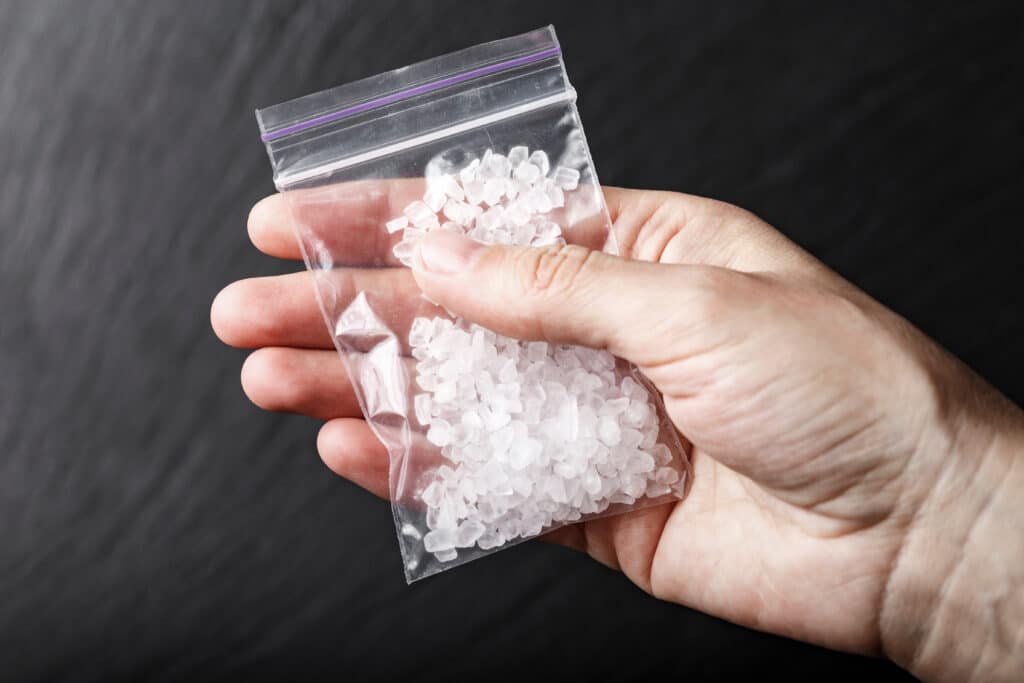
Meth works by altering the brain’s natural reward system. It triggers the release of dopamine, a chemical neurotransmitter that is responsible for feelings of pleasure and reward. During an intense surge of dopamine in the brain produced by meth, users will continue to seek out the drug in order to feel the same effects.
Addiction is a chronic and relapsing disease. It is characterized by compulsive drug-seeking behaviors that are accompanied by functional and chemical changes in the brain.
Meth is considered one of the most difficult addictions to overcome. Its highly addictive nature can also produce long-lasting feelings of euphoria, which also leads to overdose. According to research, meth accounts for an estimated 22.6% of U.S. drug overdose deaths in 2020.
Methamphetamine is commonly referred to as meth or crystal meth. Meth comes in a crystalline powder that is usually off-white or light pink.
The crystal-like tiny structures can be shiny or dull and are often snorted, injected or taken orally. Crystal meth or ice, resembles chunky rock-like shards that vary in shape and size. It has a bluish or white tint and can be smoked or injected.
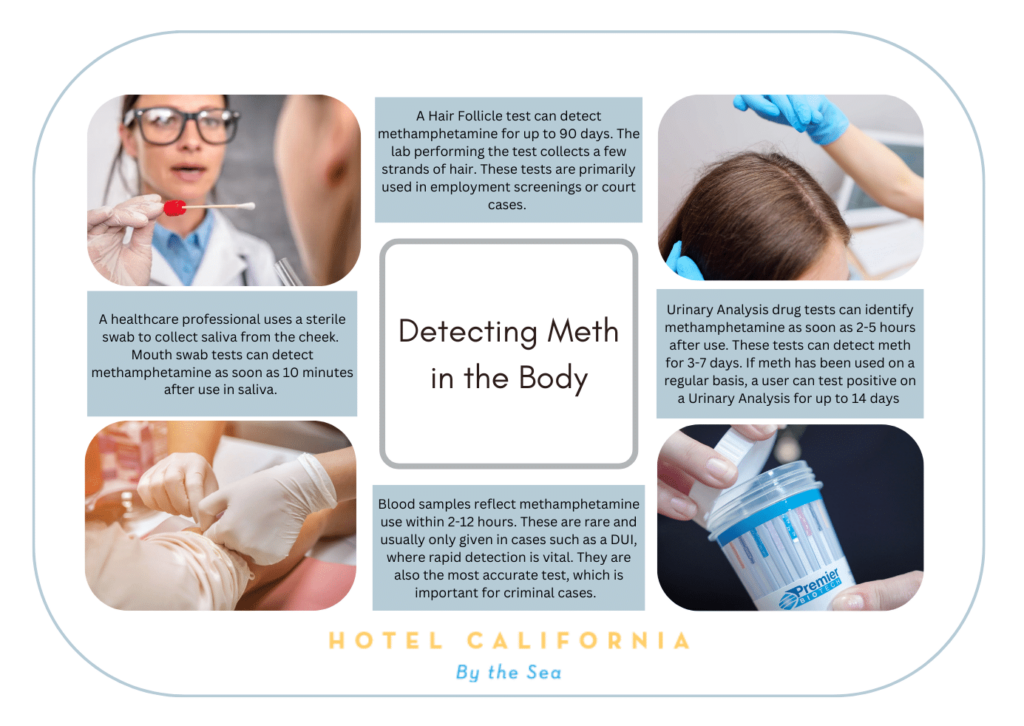
The Schedule II controlled substance can be used to treat severe ADHD or obesity because it can help boost concentration and lower appetite. Desoxyn is the only existing medication meth used for the treatment of ADHD and obesity. However, it is rarely used for any medical purposes due to its addictive nature.
Because it is considered an illegal substance, meth is often made using everyday household products. Some of these products include lithium from car batteries, brake fluid, drain or toilet cleaner, nail polish remover, paint thinner and over-the-counter ephedrine found in most cough medicines. This makes the drug even more dangerous and unpredictable due to its unregulated nature. It is often made in illegal homes that can cause toxic fires producing deadly poisonous fumes.
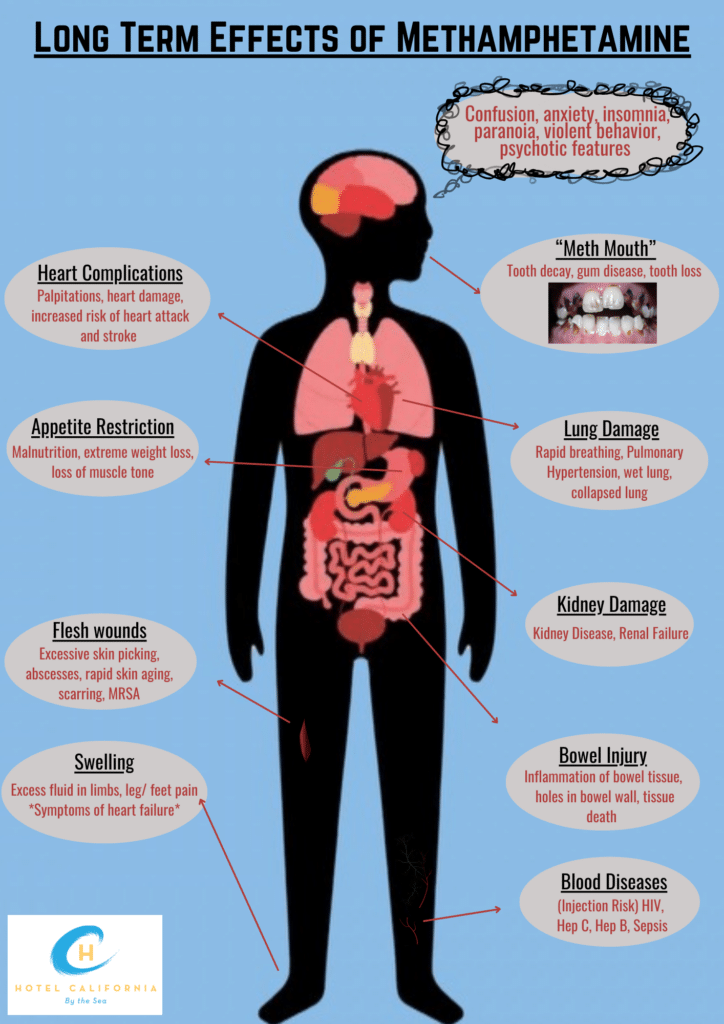
How long does Meth stay in your urine?
Though meth can have lasting effects on the body, once the effects subside, the remnants of the substance can remain in the body for much longer. Urine tests can detect traces of meth up until the first week after initial use. On average, meth can be detected in the urine between 1-10 days after use.
For first-time users of meth, a urine test can detect the drug up two a few days after use. For frequent users, a urine test can detect the drug for up to a week after use. This is due to multiple uses of the drug that can linger in the body for longer periods of time.
When meth enters into the bloodstream, the body breaks it down into chemicals called metabolites. The body absorbs some of these metabolites while some of them end up in the kidneys and eventually make their way into the urine. Approximately, 37-55% of the meth will expel with the urine chemically unchanged.
How long does Meth stay in hair?
Traces of meth can also end up in your hair. In fact, hair follicle tests can reliably detect meth for up to 90 days after the last drug use. When hair grows, it pushes the cells out of your hair follicles.
Despite these cells now dying, it is still able to trap any meth residue absorbed inside the hair before it was pushed out. Therefore, examination of strands of hair can result in consistent outcomes for drug testing.
Other types of tests that can detect meth in the system include blood and saliva tests. Blood tests can detect meth for up to 3 days after initial use. Saliva tests can detect meth for up to 4 days after initial use.
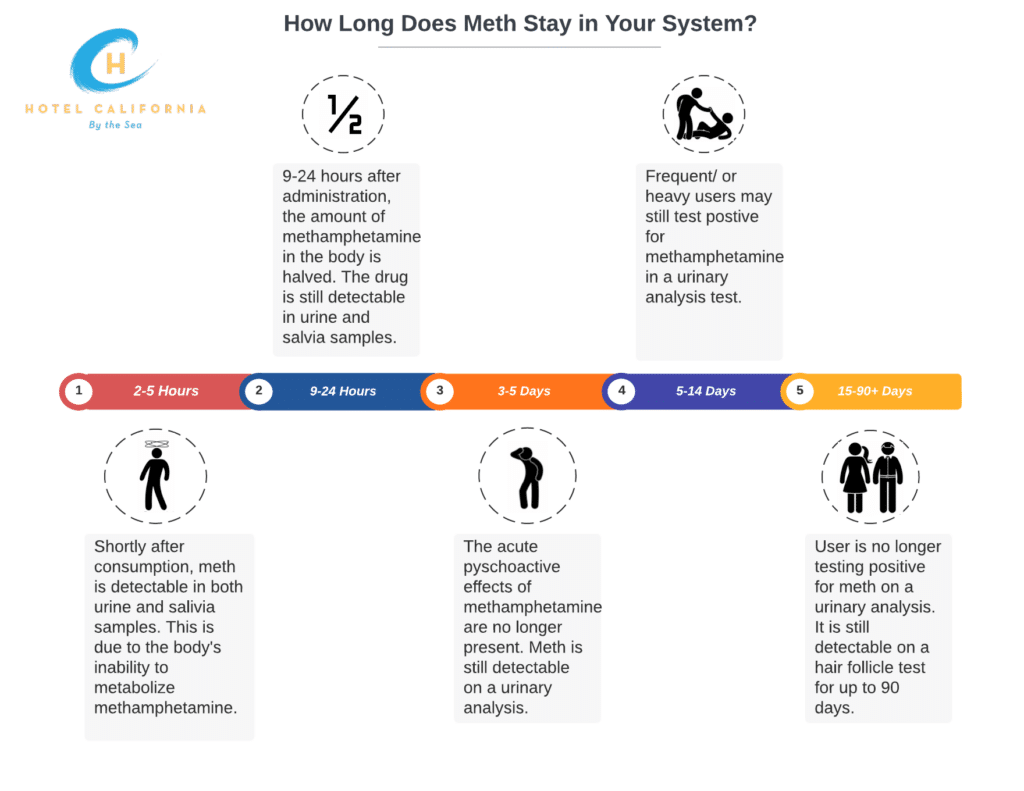
How long are the effects of Meth and what are the key factors influencing the duration of Meth in the system?
Despite its ability to produce an intense high very quickly, the effects of meth tend to wear off just as quickly as they came. However, meth chemicals can remain in the body for up to three days after initial use. Meth half-life is an average of 9-24 hours. The half-life of a drug is the period of time it takes for the drug’s active ingredients to decrease by half in the body.
Upon initial dose, a meth rush can last between 5-30 minutes. The rush is then followed by a longer meth high that can last for up to 16 hours. During this time users often experience increased awareness, rapid thinking patterns and speech and engage in obsessive behaviors.
When the high wears off, the user may begin to binge, where they will continually take more and more drugs in order to achieve the same effects until the body stops responding and producing a high. This phase of drug use can last between 3-5 days. In the final stages of meth use, users begin “tweaking” when all side effects have worn off and withdrawal symptoms have set in. Users become very vulnerable during this stage and often experience extreme frustration, paranoia and drug-induced psychosis.
The length, duration and severity of meth effects on the body can depend on a number of factors.
- Form of administration – The rush from meth injected produces the strongest effects that can last up to 30 minutes. Smoking or injecting meth quickly moves it into the bloodstream causing an immediate rush that is extremely pleasurable, but quickly fades. Snorting or oral ingestion produces a euphoric high but not an intense rush. The effects can occur within 3-5 minutes through snorting, while the oral route can take within 15-20 minutes.
- Overall health and wellness and any genetic predisposition – Kidney and liver health can determine how well or how fast a body can process and remove meth from the body.
- Metabolism – A faster metabolism processes the meth faster and is usually a trait found in younger people.
- Age, weight and gender
- Amount used
- Frequency of drug use – How often you binge and crash can affect how the drug responds to your body.
- Purity and quality of the drug
- Environmental influences
- Use of other substances – Other substances that can affect the outcome of Meth duration and effects include antibiotics, stimulants, decongestants, antipsychotics, anti-depressants, blood pressure control medicine and diabetes medications.
Alcohol is a drug commonly combined with meth. The stimulant effects of meth can often mask the sedative effects of alcohol. This leads the user to drink more and can lead to alcohol poisoning.
Another polydrug combination of opioids and meth known as “speedball” can produce a greater high. However, it puts the user at a much higher risk for overdose.
Anti-anxiety medications such as Xanax are another popular combination with meth. Meth often produces mental health feelings of extreme anxiety and Xanax is a way to combat those symptoms. Meth is a stimulant that speeds up the heart rate, while Xanax is a depressant that slows down the heart rate. The combination of the two drugs pushing and pulling against the organ can lead to a heart arrhythmia among other things.
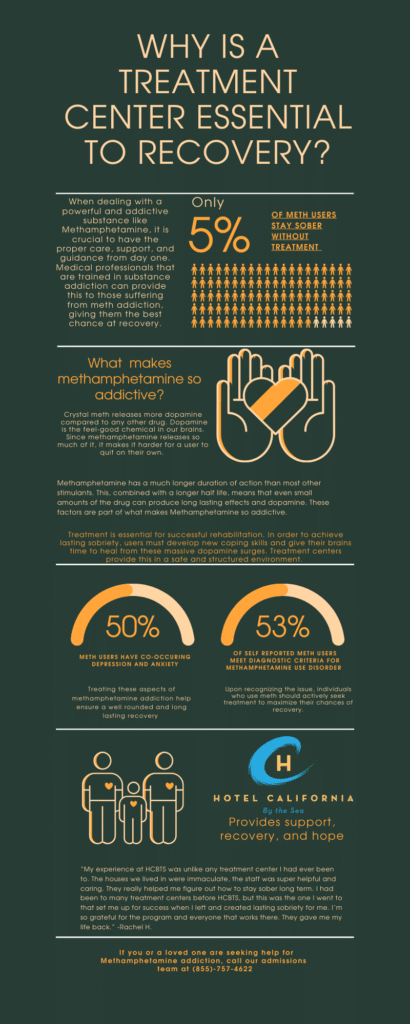
Effects of Meth on the brain and body
Meth works by producing an initial intense rush. This is especially true for first-time users. Meth floods the brain with drastic levels of dopamine resulting in a chemical response of intense pleasure, reward and motivation. This creates a powerful reward incentive for the user to keep using in order to feel the same high.
Over time, the brain is unable to naturally produce desired dopamine levels and the user becomes dependent on the drugs to make them feel “normal” and larger doses in order to feel “high.” This leads to the meth addiction cycle. When the high is over, users will feel low and depressed.
The dopamine and serotonin depletion can also cause body aches, lethargy and confusion. It drives users to seek out another round of dopamine that can only be supplied by the meth.
Other side effects of Meth Addiction include:
- Meth can make the user more talkative, social and productive
- Meth can cause bizarre behaviors where users become distant from positive social relationships
- Changes in brain structure and function
- Impaired thinking and motor skills – poor balance and coordination
- Increased distractibility – inability to focus
- Memory loss
- Aggressive or violent behaviors in drug-induced episodes
- Severe mood swings
- Sleep disorders
- Severe weight loss and malnourishment
- Severe dental problems – tooth decay and meth mouth
- Skin sores from scratching and itching
- Worsening anxiety and depression
- Elevated body temperature
- Increased heart rate
- Increased blood pressure
- Dilated pupils
- Chronic nosebleeds – snorting meth can cause sinus cavities and damage to the nasal passageways
- Psychosis – visual and auditory hallucinations, delusions and time distortions
- Cardiovascular disease – sudden cardiac arrest, acute and chronic myocardial toxicity and coronary artery disease
Ultimately, meth can change the way the brain works and functions. Brain scans have shown meth users can suffer from severe structural and functional changes in areas of the brain that are associated with emotion and memory.
It can also kill brain cells, which result in long-term damage to memory, attention and some executive functioning skills. Psychotic symptoms are common in meth users and addicts. Oftentimes users experience confusion and hallucination that can last for months and even years after a person quits using meth.
Check Your Insurance Coverage for FREE
Find out if your insurance covers addiction treatment in minutes. We accept most insurance!
How do you help someone you suspect is abusing Meth? What are the signs to look for?
If you suspect someone you know is abusing meth, there are some signs to be on the lookout for. A decrease in appetite and dramatic weight loss is a common physical trait for someone abusing meth. This person may develop a nervous activity such as itchy, scratching or picking at the skin creating skin abscesses, that don’t seem to heal.
Users can develop sensitivity to loud noises. They can begin expressing signs of psychosis, which include extreme paranoia, extreme mood swings and constant twitching. Their anxiety and depression seem to be worsening followed by a session of chronic fatigue and sleep disorders. A combination of these symptoms can be signs of meth abuse and addiction.
Reach out to Hotel California by the Sea
We specialize in treating addiction and other co-occurring disorders, such as PTSD. Our Admissions specialists are available to walk you through the best options for treating your addiction.
In more extreme cases, a professional behavioral health treatment program would be in the best interest of the suspected meth user. Hotel California by the Sea provides substance use disorder treatment for clients with a methamphetamine addiction. A full spectrum program that provides detox, residential, PHP and IOP treatments will be the most effective for clients looking to overcome their addiction.
Unique treatment methods such as CBT, DBT and family therapy have been scientifically proven to provide effective results toward sobriety and recovery. Hotel California by the Sea also specializes in treating dual diagnosis.
Oftentimes, addiction to meth is followed by the development of corresponding mental illness or vice versa. Treating both conditions simultaneously produces a better outcome of long-term recovery. Hotel California by the Sea provides clients with all the necessary tools and resources to overcome their meth addiction.
References:
https://www.healthline.com/health/substance-use/how-long-do-methamphetamines-stay-in-your-urine
https://recovered.org/stimulants/meth-methamphetamine/how-long-does-meth-stay-in-your-system
https://www.hazeldenbettyford.org/addiction/methamphetamine-symptoms
https://www.medicalnewstoday.com/articles/309287#what-is-it
https://www.addictioncenter.com/drugs/meth/
https://www.scbh.com/how-long-does-meth-stay-in-your-system/
https://npaddictionclinic.com/blog/how-long-does-meth-stay-in-your-system-2/
